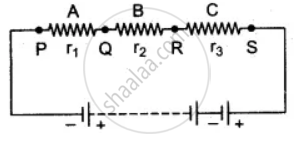Advertisements
Advertisements
प्रश्न
Suppose there are three resistors A, B, and C having resistances r1, r2, and r3 respectively. If R represents their equivalent resistance, establish the following relation R = r1 + r2 + r3 when joined in series.
उत्तर
Let the three resistors be joined in series in given figure.
Let potential at P, Q, R and S are Vp, VQ, VR, and VS respectively and current i flows in the circuit.
Applying Ohm's law,
Vp + VQ = ir1 ...(i)
VQ - VR = ir2 ....(ii)
and VR - VS = ir3 ....(iii)
If the total effective resistance between P and S be R', then the potential difference:
VP - VR = iR' ....(A)

Adding (i), (ii) and (iii)
VP - VQ + VQ - VR + VR - VS = ir1 + ir2 + ir3
or VP - VS = i (r1 + r2 + r3) .... (B)
Comparing (A) and (B), we get
iR' = i (r1 + r2 + r3)
or R' = r1 + r2 + r3
APPEARS IN
संबंधित प्रश्न
How much energy is given to each coulomb of charge passing through a 6 V battery?
How much work is done in moving a charge of 2 C across two points having a potential difference of 12 V?
What is the potential difference between the terminals of a battery if 250 joules of work is required to transfer 20 coulombs of charge from one terminal of battery to the other?
What do you understand by the resistance of a wire?
A 10 m long wire of a particular material is of reistance 5Ω What will be the resistance of 5m long wire of same material and the same thickness.
A 10 m long wire of a particular material is of resistance 5Ω What will be the resistance if the wire is doubled itself.
State Ohm’s law.
Which of the following represents voltage?
How will you conclude that the same potential difference (voltage) exists across three resistors connected in a parallel arrangement to a battery?
Study the following circuit and find:

- Effective resistance of the circuit
- Current drawn from the battery
- Potential difference across the 5 omega resistor
